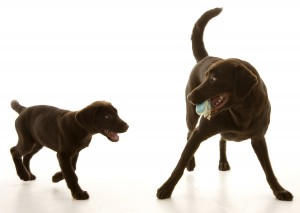What vision do you have for your dog? What does he or she need to do to be “perfect” for you? How can you go beyond perfect? This lesson discusses the concept of empowered animal care.
[s2If current_user_cannot(access_s2member_ccap_course_003_ep)]
To view this lesson, please purchase this course or log in if you have already purchased it.[/s2If]
[s2If current_user_can(access_s2member_ccap_course_003_ep)]
THE PERFECT DOG
 “What do you want your dog to do?” is a mantra among force-free trainers. When clients come to us with behavior that they want to get rid of, we rephrase the question in this positive form. If we know what we want the dog to do, we can reinforce that behavior and get that happening instead of what we don’t like. If we don’t like pulling, we can reinforce heeling or loose leash walking. If we don’t like jumping up, we can reinforce four paws on the floor.
“What do you want your dog to do?” is a mantra among force-free trainers. When clients come to us with behavior that they want to get rid of, we rephrase the question in this positive form. If we know what we want the dog to do, we can reinforce that behavior and get that happening instead of what we don’t like. If we don’t like pulling, we can reinforce heeling or loose leash walking. If we don’t like jumping up, we can reinforce four paws on the floor.
That’s all well and good, but I would like to see us all take that to another level. I would like to see us ponder how we can merge our ways of life instead of only imposing our way onto the dogs, however kindly. For example, while we can certainly use reward-based training to motivate our dogs to want to walk right beside us on every walk, in a perfect heeling position, is that the right thing to do?
Teaching ‘heel on every walk’ by using positive reinforcement is certainly way better than getting that perfect heel through corrections. It’s kinder to the dog and adding unnecessary physical and emotional stress can lead to issues like poor socialization, biting the handler, and back pain. The latter even applies to the person giving the correction, because of the physical power required.
But is it even a good idea to have your dog heeling all the time on your walk, even with positive training? Having the ability to cue a heel is one thing, so you can get past distractions that are just too much for the dog if he were free to roam. But aside from very specific moments, the dog should be allowed and even encouraged to explore — off leash when it is safe. and otherwise on a loose leash. In the next lesson, I will cover the BAT leash skills, which are a way to help create a more ‘off leash’ experience when on leash.
In my opinion, if the dog is in a continuous state of working to get a treat during his walk, he’s missing out. He’s focused on earning a reinforcer, meeting an immediate need/want stimulated by the training session. When a dog is essentially addicted to heeling or other behavior for us, he is distracted from normal dog behavior that might serve his long term needs better. He is missing opportunities to learn about or interact with his environment. This is especially problematic when done with puppies.
It’s also important to focus on teaching and facilitating relaxation, down-time. Don’t just wind them up with a toy and then suddenly stop. After training or play, follow up with a chance to relax. Practice makes perfect.
So the perfect dog? For me, that is a dog who:
- communicates well with other dogs, people, and animals
- is comfortable with his environment and copes well with any occasional stress
- understands and cooperates with people when needed
I believe that this sort of thing is what we should be aiming for when we ‘train’ dogs. A training-addict that knows 200 tricks or a perfect heel may be fun for us, but have we really taken care of his needs as a dog when he can’t relax or interact well with his own species?
PHILOSOPHY OF EMPOWERMENT
 By empowerment, I mean that the puppy learns that his behavior is effective in meeting his needs. So it doesn’t mean we have a dictator with an owner jumping to fulfill the dog’s every wish, but rather a dog who knows how to get what he needs in ways that are comfortable for the humans and other animals in his world.
By empowerment, I mean that the puppy learns that his behavior is effective in meeting his needs. So it doesn’t mean we have a dictator with an owner jumping to fulfill the dog’s every wish, but rather a dog who knows how to get what he needs in ways that are comfortable for the humans and other animals in his world.
This puppy class is in the School of BAT because Behavior Adjustment Training has the same philosophy of empowerment. Letting your dog do more for himself can build confidence and allow you to teach appropriate behavior at the same time. If your puppy wants or needs something, and it’s safe for him to have it, he can learn to get it by doing behavior that helps him fit in with your family.
But there are also things we just need to do TO dogs, like brushing, injections, etc. These are not naturally motivating. Your dog is not likely to ever ask you to trim his nails unless there’s something in it for him besides for short nails. The comfort of the shorter nails is too far removed from the process of nail trimming.
Like the animals in the best zoos and aquariums, dogs can be active participants in grooming and vet care. You could just add some motivation to put up with these things, like touching his paw and then giving him a treat, but you can take that to another level to help make it less stressful for your dog. Teach specific behavior that gives him more control over the process, like when to start and stop. In the Cooperation lesson in this class, we will train with food, toys, etc. to motivate the dog to help us take better care of him.
As an example of getting dogs to cooperate in their care instead of only tolerating it, check out this video/commercial by Orapup:
You don’t have to watch that video all the way through, just watch how the dogs are actively engaged in their own care. I find it very clever because it automatically motivates the behavior we want, no training involved. Training isn’t always the answer. If there’s an easy option that also gets your dog to happily cooperate, do it!
Here’s an example of the dog doing her own grooming, which did require some training from her caretaker, Jeanie Burton. But I love that it’s all completely done by the dog!
Take time to train some other behavior for dogs actively cooperate with vet care and grooming done to them. It’s worth it for a lifetime of low-stress care.
[/s2If]